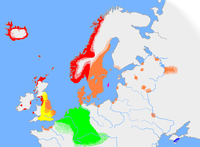Canterbury charm
The Canterbury charm is an Old Norse runic charm discovered inserted in the margin of an Anglo-Saxon manuscript from the year 1073.[1]
Inscription[]
The runes are clear, and the transliteration of the runes is straight-forward (spaces between words not present in the original):
- kuril sarþuara far þu nu funtin is tu þur uigi þik ¶ þorsa trutin iuril sarþuara uiþr aþra uari ·[2]
Gustavson (2010) normalizes it as
- Gyrils sārþvara far þū nū! Fundinn eʀ þū! Þōrr vīgi þik, þursa drōttinn, Gyrils sārþvara. Viðr aðravari.[2]
and translates it as
- Gyrill's wound-tap, you go now! You are found! May Thor hallow you, lord of the trolls. Gyrill's wound-tap. Against pus in the veins (blood poisoning).[2]
Similarly, the charm is translated by Macleod and Mees (2006) as:
- Gyril wound-causer, go now! You are found. May Thor bless you, lord of ogres! Gyril wound-causer. Against blood-vessel pus![1]
Interpretation[]
The charm is intended for use against a specific ailment, described as "blood-vessel pus." MacLeod and Mees note that while Thor is not revered in surviving sources for his medical abilities, he was well attested as harboring enmity towards giants and as a protector of mankind. MacLeod and Mees compare the charm to the 11th-century Kvinneby amulet (where Thor is also called upon to provide protection), the formula structure of the Sigtuna amulet I, and the inscription on a then-recently discovered rib bone also from Sigtuna, Sweden.[1]
Notes[]
References[]
- Gustavson, Helmer. (2010) Sårfeberbenet från Sigtuna. Situne Dei, 61-76. Relevant parts translated from Swedish by Mindy MacLeod.
- Macleod, Mindy. Mees, Bernard (2006). Runic Amulets and Magic Objects. Boydell Press ISBN 1-84383-205-4
External links[]
| Part of a series on the |
| Norsemen |
|---|
 |
| WikiProject Norse history and culture |
- Runic inscriptions
- Historical runic magic
- Norse paganism
- Sources on Germanic paganism